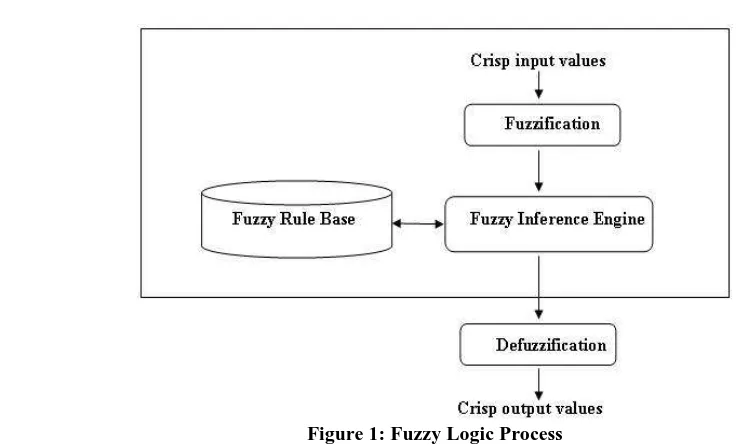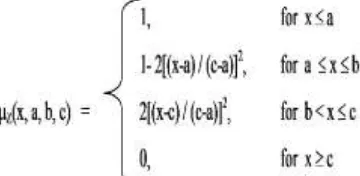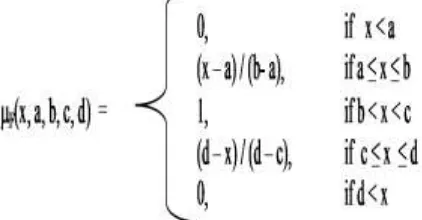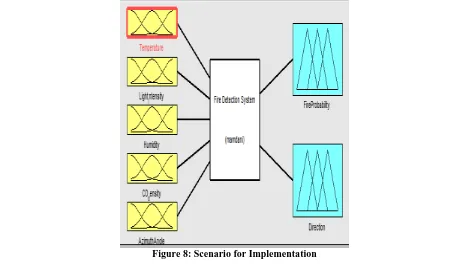e-ISSN: 2278-067X, p-ISSN: 2278-800X, www.ijerd.com
Volume 12, Issue 3 (March 2016), PP.64-72
Fuzzy Membership Functions: Selection Techniques and
Implementation in WSN
Mandeep Kaur
1, Dr.Vinay Chopra
2, Er.Lovedeep Singh
31StudentM Tech, DAVIET, Jalandhar, Punjab, India 144008. 2Department of CSE, DAVIET Jalandhar, Punjab, India 144008.
3
RIET Phagwara, Punjab, India 144008.
Abstract:- Fuzzy set is very convenient method for representing some form of uncertainty. Basically, the most important application of the fuzzy set theory is its ability to represent mathematically a class of decision problems called multiple objective decisions. The problems related to this class often involve many goals and constraints. The main objective of the fuzzy decision methodology is to obtain an optimum decision in the sense that some set of goals is attained while observing a set of constraints simultaneously. The fuzzy set theory uses many membership functions which help to attain the desired results and it helps in decision making with more precision. In this paper we are going to study the membership functions used in the fuzzy set theory. These membership functions are explained thoroughly in this paper and later the difference between these memberships functions are shown according to the scenario used for detection of the forest fire. The effect of using different membership functions on the decision making is thus shown in this paper. The most efficient member function can thus be used for making a system that can help us in decision making more efficiently.
Keywords: - Fuzzy Sets, Membership Functions, Decision Making, Fire Detection.
I.
INTRODUCTION
Figure 1: Fuzzy Logic Process
Fuzzy logic has a rule base which it uses when a decision making process has to be initiated. The values thus given to an fuzzy inference engine is processed with consultation to the rule base and later the de-fuzification is done so as to produce the values that helps in decision making process.
II.
FUZZY SET THEORY & FUZZY LOGIC
Suppose we have a set of alternatives such as a set of cities which might be destinations for some future travel plans so therefore we let the set of four decision alternatives be denoted by:-
X = {x1, x2, x3, x4} = {Philadelphia, Los Angeles, Chicago, Newark}
The set X is a conventional set of objects so therefore we will define a fuzzy subset of the set X and we call it A which is characterized by a membership function μA(xi) associating with each xi X a number in the interval [0,1] which indicates the grade of membership of xi in A so therefore we suppose for our example A asa fuzzy subsets which is defined as:
A = {the city in X is near New Jersey} = {0.7/x1, 0.003/x2, 0.1/x3, 0.9/x4}
where the first number in each pair represents the membership value μA(xi) and the second denotes the individual set member xi and the second number in each pair can be dropped with the understanding that the fuzzy subset A of X is characterized by the individual μA(xi) and is indexed identically with the elements xi as an example we have
μA(x3) = μA(Chicago) = 0.1
Note the increasing membership values as the indexed cities come closer to New Jersey with Newark having the largest membership and if the set X were enlarged to include Brooklyn and Queens as x5 and x6, they would have membership values of 1.0 and since both are not only near New jersey they are suburbs within New Jersey and are contained in the target city characterizing the fuzzy set A and the concept of a fuzzy set includes that of a classical set as a special case by using a step function as the fuzzy membership function and therefore we let the fuzzy set A defined on the set X of integers between {1,5} will be defined as the set of integers larger than three and therefore we have:
X = {1, 2, 3, 4, 5} and A = {0/1, 0/2, 0/3, 1/4, 1/5}.
III.
OPERATIONS ON FUZZY SETS
The various operations that can be employed on fuzzy sets are explained in this section. The various operations are as follows:
3.1 Complementation
The reasonable operation to consider on a fuzzy set would be complementation and the following examples shows how would you describe the complementary set to A of the first example above? Probably, it would seem reasonable to consider the complement in English of the word "near", which is "far". Given that we know how to characterize the fuzzy set A and its complement is denoted as A' or A is easily computed which is having the membership values of 1-μA(). Hence, the given A above would characterize its fuzzy complement A' as:
A' = {the city in X far from New Jersey} = {0.4, 0.999, 0.9, 0.1}.
The membership values of the complementary set A' are just 1 - the corresponding μA() membership values. Los Angeles, the x2 element, has a high membership in the fuzzy set A' defined as being far from New York.
3.2 Union and Intersection
The union operation on fuzzy sets A and B defined on X is denoted as A » B and is the fuzzy set C with membership values that are the "MAX" of the component values and this operation is defined if the index sets of A and B would have same cardinality.
i.e. C = A » B Where,
μC(x) = max[ μA(x), μB(x) ]
This operation is the fuzzy analog to the normal Boolean logic operation of OR. We will let A and B be fuzzy sets defined by the respective arrays of membership values representing an attack aircraft's sensor and there three such:-
X = {x1, x2, x3} and A = {0.6, 0.5, 0.8} and B = {0.8, 0.4, 0.7}
The fuzzy set A might represent our best estimate of the relative memberships of the three sensor suites in the class of inexpensive electronics sensor suites where the fuzzy set B represent our best estimate of relative membership values in the class of battlefield detectors and the fuzzy set C represents the set of OR efficient detectors having the membership values:-
C = {0.7, 0.5, 0.9}
The fuzzy OR operation is related to the optimism of the decision maker. Suppose we wanted our sensor suite to be both inexpensive and a good detector which leads us to consider finding a fuzzy analog to the idea of AND. The fuzzy intersection is a MIN operator on the membership values of A and B and this intersection operation is only defined if the cardinality of the index sets of A and B agrees. So we will be having:-
D = A Intersection B
Where,
μD(x) = min[ μA(x), μB(x)]
The set of inexpensive and efficient sensor suites would be characterized by the fuzzy set D whose membership values are given by:-
D = { 0.6, 0.3, 0.8 }
If we were making a decision about which sensor suite to choose, then an obvious choice would be to buy suite x3 since it best satisfies our goals.
3.3 Exponentiation
Let A be a fuzzy set defined on a set X and let a be a scalar value (for all the cases of interest to us the a's will be > 0). The concept of raising the fuzzy set A to the power which is denoted by fuzzy set E is given as:
μE(x) = [μA(x)]a
A2 _ CON(A) = { 0.36, 0.25, 0.64 }
This is an example of the ability of fuzzy sets to map from English language quantifiers into quantitative measures. The value 2, when applied in this fashion is called a concentrator and when this value is used to exponentiation a fuzzy set. The value 0.5 is called a dilator and denoted as DIA()S.
DIA(A)_ A0.5 = { 0.7756, 0.7072, 0.9944 }
The set DIA (A) is the fuzzy set membership values in the set of inexpensive sensor suites.
IV.
MEMBERSHIP FUNCTIONS IN FUZZY LOGIC
The various membership functions are discussed in this section. The membership functions play a vital role in decision making. The membership functions are shown along with their pictorial representation in this section. The pictorial view helps in determining the process of each membership function.
a. S-Shaped Membership Function
This sp-line based curve is a mapping on the vector x which is named because of its S shape. The A and B parameters locate the extremes of the sloped portion of the curve and is given
by:-Figure 2: S-Shaped Membership Function
b. Z-shaped Function
This spline-based function of x is so named because of its Z shape and the a and b parameters locate the extremes of the sloped portion of the curve and is given by:-
Figure 3: Z-Shaped Membership Function
c. Triangular Membership Function
The Triangular membership function is defined by a lower limit a, an upper limit b, and a value m, where a < x< b.
d. Trapezoidal membership Function
The trapezoidal curve is the function of a vector x and it depends on four scalar a, b, c, and d parameters. Its expression is given by:
Figure 5: Trapezoidal Membership Function
e. Gaussian Membership Function
This membership function basically depends only on two parameters sig and c. The expression is given as:-
Figure 6: Gaussian Membership Function
The function is a combination of two parameters and the first function is specified by sig1 and c1 which determines the shape of the leftmost curve and the second function sig2 and c2 determines the shape of the rightmost curve and also whenever c1 < c2, the Gaussian member function reaches a maximum value of 1 in all other cased the maximum value is less than one.
f. Pi Function Member Ship Function
Pi-shaped curve is a spline-based curve which is named because of its shape. This membership function is evaluated at four points a, b, c, and d from which parameters a and d locate the feet of the curve while b and c locate its shoulders. The graph given in figure a = 2 b = 4 c = 5 d = 9.
Figure6: Example of Pie Function
g. Vicinity Function
V.
METHODS FOR DETERMINING MEMBER SHIP FUNCTION
Membership functions can be designed by analyzing the problem in hand. There are many possible forms of membership functions and many of the fuzzy control operations are drawn from a small set of different curves. The methods for determining membership functions may be broadly classified into the following categories which are explained briefly as follows:
a. Subjective evaluation and elicitation
Since fuzzy sets are usually intended to model cognitive states and they can be determined from certain elicitation procedures. These procedures are provided by the experts in the problem area. More constrained set of possible curves are given from which an appropriate one could be taken and hence the users can be tested using various tests for more complex methods which can be more efficient.
b. Converted Frequencies or Probabilities
It may be possible to use information taken in the form of frequency histograms or other probability curves as the basis to construct a membership function each with their own methodological and mathematical strengths and loop holes and it should always be remembered that membership functions are not equivalent to probabilities.
c. Physical Measurement
Many applications of fuzzy logic use physical measurement and almost none of them directly measure the membership grade. A membership function is obtained from various other methods then used to calculate any data’s individual membership grades.
d. Learning and Adaptation
Membership functions of fuzzy sets could be adapted and learned from a given set to a function which suits the application.
VI. RESULTS a. Scenario for Wildfire Detection
The Scenario which we are using in this implementation is for decision making in wildfire detection which implements the clustering technique and uses the cluster switched gateway routing protocol for the effective communication. The four input parameters that are part of implementation are:-
Temperature
Humidity
Light Intensity
Carbon Monoxide
There is use of 324 inference rules in the implementation. The platform used for implementation is MATLAB.
b. Pictorial View for each Member Function
This section shows the pictorial view of various member functions discussed above:
Figure9: S-Shaped Membership Function
Figure 12: Gaussian Membership Function
Figure 13: Trapezoidal Membership Function
Figure 15: Vicinity Membership Function
VII.CONCLUSION
The membership function for a fuzzy set A on the universe of discourse X is defined as µA:X → [0,1]
where each element of X is mapped to a value between 0 and 1 and the value is called membership value or the degree of membership quantifies the grade of membership of the element in X to the fuzzy set A. The Membership functions allow us to represent a fuzzy set graphically. The x axis of the graph represents the universe of discourse and the y axis of the graph represents the degrees of membership in the interval [0, 1]. The result shows us which of member function should be used according to the requirement of building the system. The scenario we were taking was of the wildfire detection so we concluded from the above results that the Gaussian membership function will be best suited for building this type of decision making system. The Gaussian membership function produces smooth curves than its counterpart and we are able to get values at every single point which the Triangular, Trapezoidal or Pei member functions cannot produce. So based on the study in this paper for making a Wildfire detection scheme the Gaussian member function will produce the efficient results. The Gaussian function in our scenario will help us in decision making and will take the approach to the right direction and there should be less uncertainty.
REFERENCES
[1]. Bellman, R.E. and L.A.Zadeh.1970."Decision Making in a Fuzzy Environment," Management Science, 17,141-164.
[2]. Heshmaty, B. and Kandel, A. (March 1985)."Fuzzy linear regressions and its applications to forecasting in uncertain environments,"F uzzy Sets and Systems, 15:2,159-191.
[3]. Yager, R.R. 1977."Multiple Objective Decision-Making Using Fuzzy Sets," Intl. J. Man-Machine Studies, 9, 375-382.
[4]. Zimmermann, H.J., 1985. Fuzzy Set Theory and Its Applications, Kluwer Nijhoff Publishing, Boston, MA.
[5]. Cheng, Wen-Ying, Ender Su and Sheng-Jung Li. “A Financial Distress Pre-warning Study by Fuzzy Regression Model of TSE-Listed Companies.” Asian Academy of Management Journal of Accounting and Finance 2, no. 2 (2006): 75–93.
[6]. Brotons, Jose M., and Antonio Terceno. “Return Risk Map in a Fuzzy Environment.” Fuzzy Economic Review 16, no. 2 (November 2011) Cox, Earl. The Fuzzy Systems Handbook: A Practitioner’s Guide to Building, Using and Maintaining Fuzzy Systems. Boston: AP Professional, 1994: 107–268.
[7]. Zimmermann, H.J. and P. Zysno. 1980. "Latent Connectives in Human Decision Making," Fuzzy Sets and Systems, 4, 37-51.
[8]. Whaley, C.P. (November 1979). "Fuzzy Decision Making Interface Age, 87-91
[9]. O'Hagan, M. 1990. "A Fuzzy Neuron Based on Maximum Entropy Ordered Weighted Averaging," [10]. Proc. 24th Ann. Asilomar Conf. on Signals, Systems, and Computers, 2, 618-623, IEEE and Maple
Press, Pacific Grove, CA.






